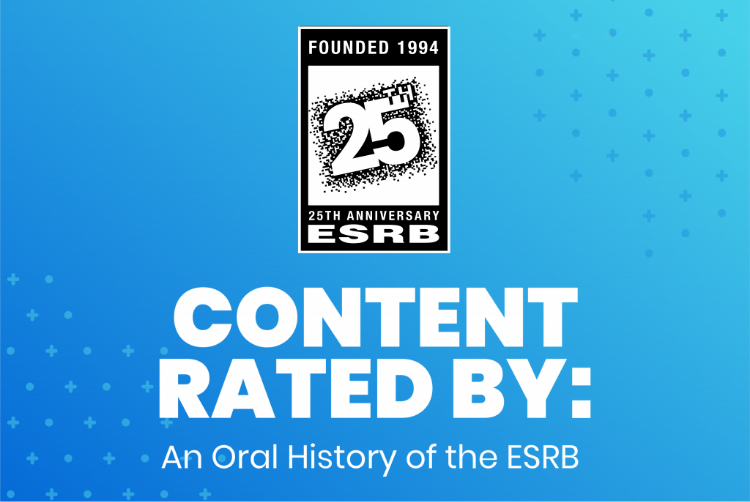Our History
ESRB founded by the Interactive Digital Software Association (IDSA was renamed Entertainment Software Association in 2004)
New ESRB rating system announced, with 5 rating categories and 17 content descriptors





Advertising Code of Conduct created and adopted by the IDSA
ESRB rating system established for websites, with 5 rating categories and 22 content descriptors
Online Rating Notice established to warn consumers of user-generated content in online-enabled games and on websites
K-A (Kids to Adults) rating category changed to E (Everyone)
First ESRB Public Service Announcements launched featuring Tiger Woods, Derek Jeter and Regis Philbin
Non-pixelated versions of rating symbols introduced
Advertising Review Council established as division of ESRB to monitor compliance with industry-adopted marketing and advertising guidelines
ESRB enforcement system established to impose sanctions, including points, fines and corrective actions, on companies who do not comply with ESRB rules and guidelines
New target marketing guidelines for Mature-rated games introduced
ESRB Privacy Online certification service launched and sanctioned by the FTC as a “Safe Harbor” under COPPA
Arthur Pober departs as ESRB’s founding president; Patricia Vance joins ESRB as its new president
ESRB rating system for websites discontinued
E10+ rating category introduced for games that may be suitable for ages 10 and older
ESRB increases fine up to $1 million for non-disclosure of pertinent content
ESRB Retail Council (ERC) launched by ESRB and leading computer and video game retailers; “ERC Commitment to Parents” is adopted by all ERC retail members
National radio and TV PSA campaign promoting ratings awareness launched with U.S. Senators Hillary Rodham Clinton and Joseph Lieberman
ESRB launches its first PSA campaign featuring artwork by Penny Arcade
The Federal Trade Commission (FTC) finds eight in ten underage buyers are turned away when attempting to purchase Mature-rated games
PTA and ESRB release “Parents Guide to Video Games, Parental Controls and Online Safety”
Rating summaries are introduced along with ESRB’s mobile website
ESRB Privacy Online launches E.U. Privacy Seal Certification program
The FTC’s sixth follow-up Report to Congress lauds ESRB for having “the strongest self-regulatory code” and confirms that retailers have maintained their 80% store policy compliance rate
ESRB launches PSA campaigns with the New Orleans Saints and Chicago Blackhawks, both of which include TV and radio ads running in their respective regions as well as in-stadium/arena
The ESRB Website Council (EWC) is established to help ensure that game enthusiast sites post complete rating information and employ age-gates on trailers and videos for M- and AO-rated games
The FTC’s mystery shopper study finds enforcement of entertainment ratings to be “highest among video game sellers” with 87% overall compliance
ESRB introduces an automated, streamlined process for assigning ratings to console downloadable games
The U.S. Supreme Court rules in Brown v. EMA/ESA that video games qualify for First Amendment protection and the sale of violent games may not be restricted by law, a landmark decision that recognized the effectiveness of the ESRB rating system
ESRB is commissioned by the CTIA, the trade association representing wireless carriers in the U.S., to develop and administer a rating system for mobile apps
ESRB launches TV, radio and in-arena PSA campaign with the Washington Capitals
ESRB releases a new print and online PSA campaign featuring real-life parents and gamers and artwork by Penny Arcade
ESRB launches TV and radio PSA campaign with the San Francisco Giants with airings in AT&T Park and throughout the Bay Area during the 2012 MLB season
Interactive Elements added to ESRB ratings for digital games and apps
ESRB introduces a digital rating service to provide cost-free ratings for digitally delivered games
The FTC announces that video game retailers continue to have the highest level of store policy enforcement as compared to other entertainment retailers with 87% overall compliance
ESRB’s Safe Harbor privacy program is re-branded ESRB Privacy Certified featuring new seals and privacy resources for existing and new members

International Age Rating Coalition (IARC) is incorporated
International Age Rating Coalition (IARC) begins assigning ratings to games and apps on Mozilla’s Firefox Marketplace
The Australian Classification Board (ACB) becomes an IARC participating rating authority
The Nintendo eShop deploys the IARC rating system for all digitally delivered video games and apps
Google Play deploys the IARC rating system, resulting in the display of ESRB ratings for all apps available in North America
The Windows Store deploys the IARC rating system for all digitally delivered games and apps
The Oculus Store deploys the IARC rating system for all VR games and apps
Republic of Korea’s Game Rating and Administration Committee (GRAC) becomes the newest participant in the IARC rating system
ESRB begins assigning Interactive Elements to physical (e.g., boxed) games, including In-Game Purchases and Users Interact
PlayStation deploys IARC on the PlayStation Store to display ESRB ratings for all digitally delivered games, including for PlayStation VR
ESRB and Penny Arcade launch their third PSA campaign, featuring both artwork and voiceover from the Penny Arcade team
Origin deploys the IARC rating system for all digitally delivered games
ESRB introduces In-Game Purchases (Includes Random Items) Interactive Element
ESRB launches ¡Vamos a Jugar! (or “Let’s Play” in English) to help Spanish-speaking parents and guardians learn about the ESRB rating system, parental controls, and more
Google Stadia deploys the IARC rating system for all digitally delivered video games
ESRB introduces the RATING PENDING – LIKELY MATURE 17+ notice that publishers can include in advertisements and promotional materials for upcoming video games that have not yet been rated but are anticipated to be rated Mature 17+
Amazon Luna deploys the IARC rating system for its cloud gaming platform
Pico deploys the IARC rating system for its VR games and experiences
ESRB launches The Family Gaming Guide, a new resource to help parents manage their kids’ video game experiences and keep peace of mind
